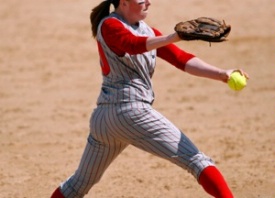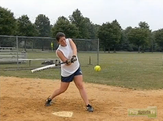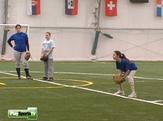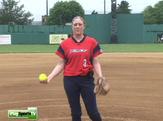PlaySportsTV Softball
Girls' Fast Pitch Softball: How to Develop a Pitcher

How to Develop a Girls' Softball Pitcher
By Mary Ann Tarr
PlaySportsTV Contributor
Adults far and wide have heard variations of a sentence that begins with “Please make me a …”
Sometimes it is directed at a parent and is followed by a simple request such as “sandwich.’’ Other times the youngster has a desire to have even more on their plate.
For those adults who are hearing phrases such as “make me a pitcher,” here are some guidelines to safely develop and prepare girls’ softball players for a happy and healthy experience.
(Develop fundamentally sound softball pitchers with Learn from the Pros: Fundamentals of Fastpitch Softball Pitching. In this great instructional video, a pro pitcher breaks down the Fastball Grip.)
“You’ll have fathers and mothers who have a child who has expressed an interest in pitching and a mom and dad who make sure they go to the extremes (in good and bad ways),” says Ed Steele, coach of the Broad Run (Ashburn, Va.) team that in 2008 completed an undefeated season and finished No. 1 in the final USA Today/NFCA Top 25 High School Softball Poll. “The best (pitchers) I’ve had, they want to be out there. The trick is to let the kid be the kid. Knowing if they have a knack for (pitching) and making sure they know that if you’re a pitcher you can’t just go to practice a couple of times a week and get really good. But trying to push a kid into being a pitcher is the worst thing you can do.”
It doesn’t have to be quite so serious when they first start out, which according to Susan Seaver, tournament director of the Little League Softball World Series, should probably be in the 8- to 10-year-old range.
“Eight, 9, 10 years old,” is a good time to begin, Seaver says. “We’re playing fast pitch and teaching them just a straight fastball to try to get them to get it over the plate. Just play catch with the catcher to start them out. Sometimes the kids won’t ever do a windmill, they’ll just reach back and throw it.” Later on, in the 10-12 age group, a softball pitcher can add an off-speed pitch followed by another pitch or two through the years.
Barry Haftel, a vice president of the 2008 World Series finalist Robbinsville (N.J.) Little League and an assistant district administrator for softball tournaments in New Jersey, agrees that early preparation and lots of positive reinforcement are keys to good pitching.
“In Robbinsville Little League, we start our pitchers at age 8 whenever possible and encourage anyone interested in pitching to start no later than 9,” Haftel says. “Reason is, it takes a good six months for a player to grasp the concept and become capable of pitching in a game.”
The consensus says that there are certain kids who are best suited to become pitchers. “It’s an attractant,” says Steele, who led his team to back-to-back state championships in 2007 and ‘08. “One parent said (to his child), ‘You can be the pitcher or the catcher,’ that’s where the action is. It attracts some people. You have to have a special personality.”
“It takes a bit of a special person,” Seaver concurs. “All eyes are on you. Usually you’re a leader-type person even at that young age. You’re an outgoing type one who says things like, ‘Let’s go do this or that.’”
Softball pitchers need lots of practice and a high tolerance level to accept and overcome setbacks. “It’s pretty rare that you’ll find a pitcher who can throw strikes consistently at a young age,” Seaver says. “Sometimes you get a 9-year-old with a lot of natural athletic ability.”
“Most players need to pitch at least 2-3 times per week for an hour at a time in order to progress at a rate that will keep them pitching for years to come,” says Haftel, who notes that even the good pitchers hit plateaus along the way. “The better pitchers work through (plateaus and frustration) and continue to go on to be top pitchers in the league.”
Seaver reminds that good girls’ softball programs have rules to combat overuse of young arms by limiting the number of innings pitched. “It’s a good rule in Little League, to avoid injuries and also to get coaches to get other kids to pitch,” she said. “But, the injury factor is not so high in softball (due to the reduced stress on the arm and shoulder) because that elbow and wrist injury factor is not nearly as great in softball as in baseball (an underhand vs. overhand throw).”
“Because of the natural arm motion used in softball, less stress is put on the shoulder and elbow as opposed to the stop and start violent mechanics with baseball,” Haftel says.
A lot goes into making a pitcher, some of which they are born with and some of which they acquire through proper instruction and hard work.
“It’s an art to learn how to do it,” Seaver says. “It’s something they really have to want to do to do it well.”
###
Instruct the best coaching techniques through PlaySportsTV softball training plans.






